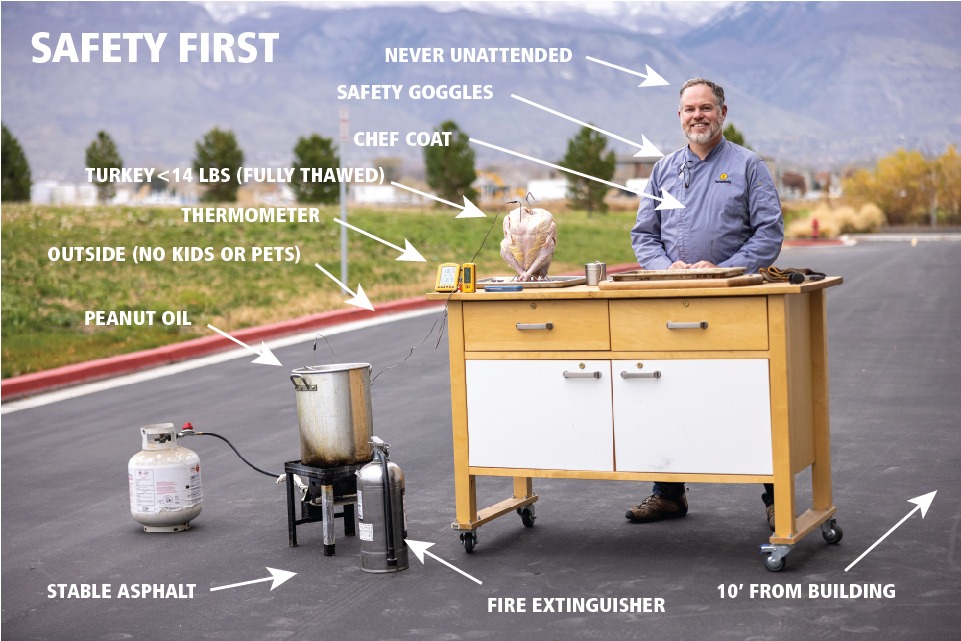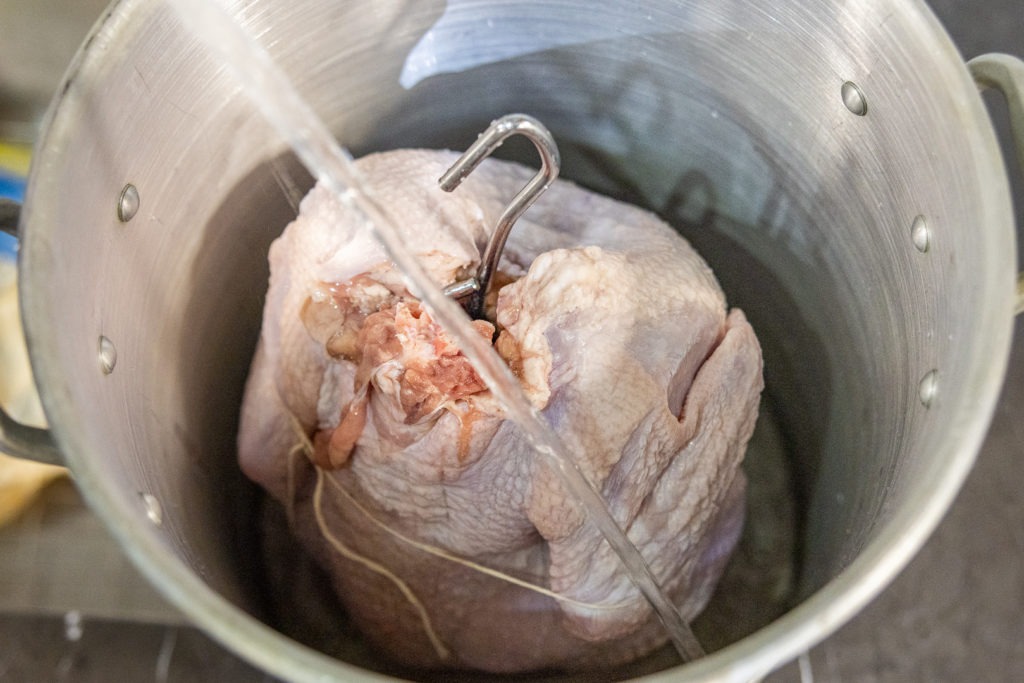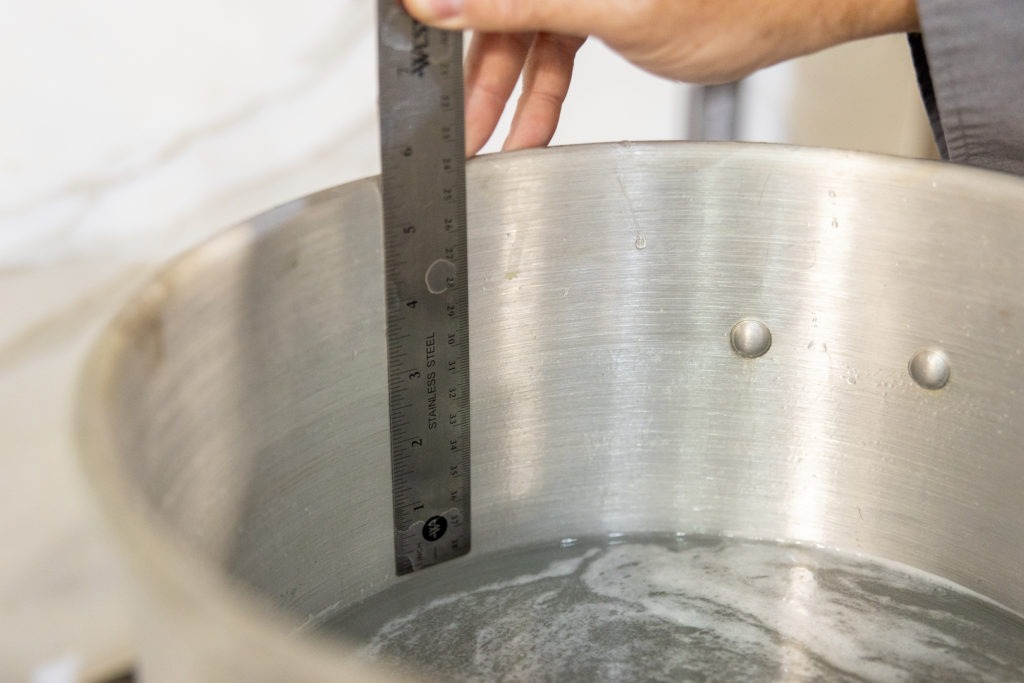Are you in the mood to try something different this year with your Thanksgiving turkey? Why not try deep frying it this year? Some say a fried turkey is the juiciest, most flavorful, crispy-on-the-outside, delicious bit of poultry ever to cross their lips. This project is packed with thermal critical control points that will determine the safety of the cook and the quality of the finished product—and we have all the tips you need.
We’ll be using the ThermoWorks® Smoke X2™ 2-Channel Alarm Thermometer with an additional 12″ Pro-Series® High Temp Probe so we can measure both the turkey meat and the critical oil temperature on the same device.
Come Thanksgiving, you’ll find many home cooks firing up their deep fryers and lowering whole turkeys into bubbling hot oil But how do you know exactly when your deep fried bird is cooked to perfection? Mastering the ideal internal temperature is key for serving up incredibly moist, tender and flavorful holiday turkey.
Why Temperature Matters
With traditional roasting methods, overcooking turkey is a common pitfall that results in dry stringy meat. Deep frying’s high heat helps avoid this by cooking the turkey fast and evenly throughout. But you still need to monitor temperature closely.
Undercooked poultry poses risks of bacteria and foodborne illness. You want to ensure the turkey reaches the safe recommended internal temperature to eliminate these hazards.
Going over the ideal temp risks drying out the delicate white and dark meat. Ping the turkey too soon, and it will be underdone. So dialing in just the right frying duration to achieve the perfect internal temp is vital.
Target Temperatures
According to the USDA, deep fried whole turkey should reach the following minimum internal temperatures for food safety:
- 165°F for the breast, wings, and thickest part of leg
- 175°F for the innermost thigh and wing
Shooting for these targets kills any dangerous bacteria while keeping the meat tender and juicy.
For best results, take the bird’s temperature in multiple spots – the deepest section of the breast, thickest part of thigh, and innermost wing. Once all those areas register within the safe zone, your turkey is ready.
Average Fry Times
So how long exactly does it take the turkey to reach the ideal internal temp? There are a few factors at play:
-
Turkey size – A small 8-10 lb turkey may need just 3-4 minutes per pound. Larger birds over 15 lbs require around 3 1/2-4 minutes per pound.
-
Oil temperature – The oil should maintain a consistent 350°F temperature. Fluctuations up or down will increase or decrease cook time.
-
Thawed vs. frozen – Only fry completely thawed turkeys! Starting from frozen will take much longer.
-
Whole vs. pieces – Whole turkeys will take longer than bone-in parts like breast, thighs or wings.
As a general guide, you can expect around 3 to 5 total minutes of fry time per pound of turkey weight. But always rely on your thermometer for doneness, not just the clock.
Step-by-Step Frying and Temp Tips
Follow these handy steps for perfectly cooked deep fried turkey every time:
- Thaw turkey completely before frying
- Heat oil to 350°F
- Lower turkey slowly into hot oil
- Fry approximately 3-5 minutes per pound
- Monitor oil temp and adjust heat to maintain 350°F
- Flip turkey occasionally to prevent bottom burning
- Start checking temperature after about 2/3 of estimated fry time
- Insert thermometer deep into thickest areas to test for doneness
- Target 165°F in breast, 175°F in thighs & wings
- Remove turkey immediately when it reaches ideal internal temp
- Let rest at least 15-20 minutes before carving
Closely monitoring temperature and adjusting your fry time accordingly is the foolproof method for delivering incredibly juicy, tender turkey direct from the deep fryer.
FAQs About Fried Turkey Temp
Confused about anything when it comes to deep frying turkey and temperature? Here are answers to some commonly asked questions:
What oil temperature should I use?
Most recipes recommend maintaining oil at 350°F for optimal safety and cooking.
Can I fry a frozen turkey?
Never deep fry frozen turkey! Always thaw first for even cooking.
When should I start taking the temperature?
After about 2/3 of the estimated cook time, begin periodically checking temperature.
Where should I insert the thermometer?
Check the deepest part of breast, thickest section of thigh, and innermost wing areas.
Is stuffing the turkey okay?
Do not stuff turkeys intended for deep frying. It can cause uneven cooking.
Can I let it soak in the oil after it’s done?
No, immediately remove the turkey once it reaches the target internal temp.
How long should I let it rest before carving?
Let the turkey rest 15-20 minutes so juices can redistribute through the meat.
Going Beyond Whole Birds
While whole deep fried turkeys may get all the glory come Thanksgiving, don’t forget about tantalizing turkey pieces as well! Parts like wings, drumsticks, thighs and breast halves lend themselves beautifully to frying.
The targeted internal temperatures remain the same:
- 165°F for breast meat
- 175°F for thighs and wings
With smaller turkeys pieces, fry times can be as little as 2-4 minutes per side, so monitor temperature closely. Brining or marinating the parts first adds even more flavor.
Make This Thanksgiving a Golden Turkey Success
Achieving the ideal internal temperature is the key to incredibly moist, delicious deep fried turkey. With a little preparation and by sticking to recommended fry times and target temps, you’ll wow your guests with the juiciest turkey they’ve ever tasted. This Thanksgiving, go for the gold with perfectly cooked deep fried turkey!
:max_bytes(150000):strip_icc()/__opt__aboutcom__coeus__resources__content_migration__serious_eats__seriouseats.com__images__2016__11__20161103-turkey-temperature-1-f5e346477afb43bf8d44a14203b85dd1.jpg)
Why fry a turkey?
Deep frying your holiday bird will take less time than roasting does. Most turkeys take about 3 minutes per pound to fry. For example, a 14-pound turkey will take about 42 minutes to cook. While your turkey is cooking outside, the oven will be available for baking rolls, pies, and side dishes.
Frying a whole turkey in hot oil can be dangerous, and caution must be observed. Thousands of fires and injuries occur every year due to turkey fryer fires. Hot oil is highly combustible, and the pot of hot oil will be sitting directly over an open flame. Follow these important tips to ensure the safety of your cook.
- Keep a dry-powder, multipurpose fire extinguisher handy at all times. Never use water to put out a grease fire, it will cause the hot oil to spatter, thereby spreading the fire rapidly.
- Take it outside. Set up the turkey fryer more than 10 feet away from your home, covered patio, roof overhangs, and any other building.
- Set up the burner on stable ground, concrete, or asphalt. Not a wood deck.
- Keep fryer away from children and pets.
- Never leave the setup unattended. Stay within a 10-foot perimeter of the hot oil at all times.
- Don’t drink and fry. The process requires full, focused attention.
- Use a thermometer. Temperature control is crucial. Do not allow the oil to exceed 350°F (177°C).
- Thaw turkey completely. The dramatic temperature difference between a frozen turkey and the hot oil will cause furious bubbling and spillage. If oil spills over the pot it can start a fire, cause an explosion, and result in injury and property damage.
- Pat the turkey completely dry with paper towels. Water on the surface will splatter when lowering the turkey. Splatters cause grease fires.
- Turn off the gas completely when filling the pot with oil, lowering the turkey into the hot oil, lifting the turkey out of the oil, or when removing the pot full of oil from the burner.
- Wear an apron or chef jacket, safety goggles, and use heavy duty elbow-length gloves.

How Much Oil Will I Need?
Too much oil in the pot will cause the oil to bubble and spill over the sides of the pot when the turkey is lowered in—and this is a dangerous fire hazard. Using enough oil and no more is an important safety precaution.


Place the turkey (set on the stand if using) into the empty pot and fill with water until the turkey is covered. Remove the turkey and measure with a ruler the distance from the top level of the pot to the top level of the water. This will be the mark to which the pot needs to be filled with oil.
